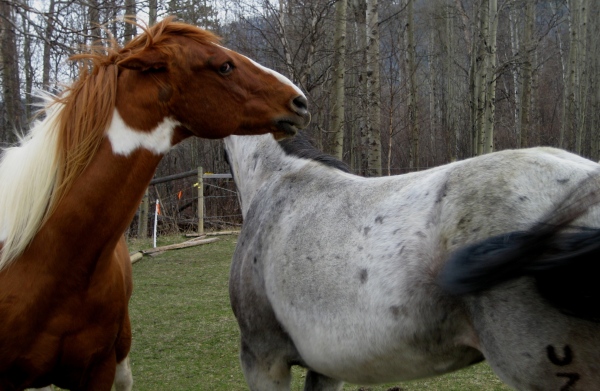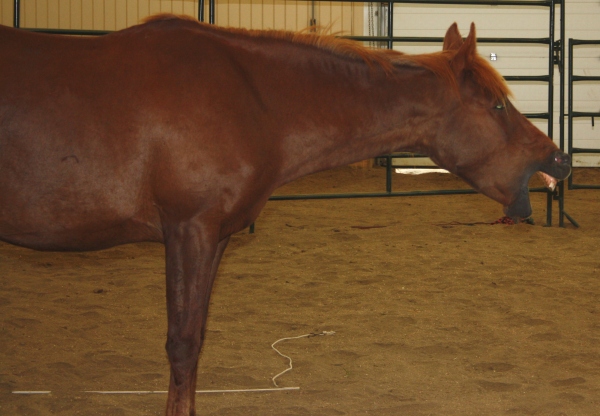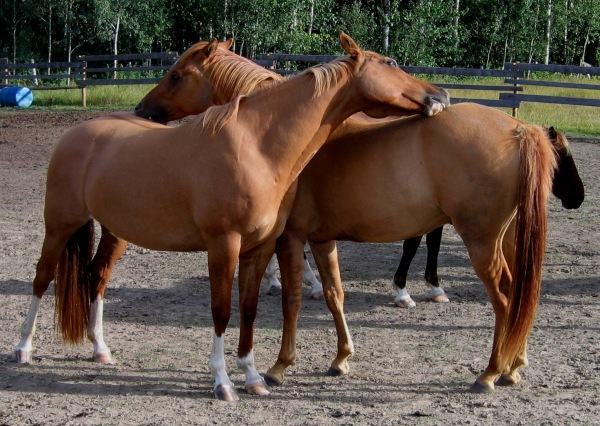Equine body language (part 1): What is your horse telling you?
Horses are social animals. Herd members interact with each other through a system of communication including sounds, body positions, movements and odours, to let herd mates know what they want and don’t want. Horses obviously don’t use words. They don’t even use sounds to any great extent. But if you watch horses as they interact with one another and with people, you will notice that body positions and movements are their main mode of communicating with each other.
One of the first things I do with any new horse, be it one of mine or one that is sent to me for training, is to turn him lose in the round pen. Having the horse lose, without any ropes or lines attached, gives the horse a chance to express himself and me a chance to read the horse and find out what he is all about. Is he a passive horse, an aggressive horse, or more something in between? Is he friendly towards people? Does he respect people? Is he fearful of humans or disrespectful and pushy? Each type of horse requires a different kind of approach. You may be saying that you are not training horses and wonder why you should bother learning how to read horses, but the truth is, every time you are with a horse, be it your own or somebody else’s, you are training the horse, for better or for worse. Understanding what your horse is saying will greatly improve your relationship with him.
It is important to understand that a horse’s body and mind are hardwired. How their bodies are shaped is how they feel (frame of body is frame of mind). Unlike people, who may smile at you even if they don’t like you, horses don’t lie. They don’t separate how they feel and how they act. What you see in the horse’s body language is how the horse feels at that given moment.
One of the most obvious ways to tell how a horse feels is the horse’s overall body outline, his frame. It’s easy to see the difference between the high-headed frame of an excited horse and the level or low top-line of a relaxed one.
Body language is essentially energy, and energy is movement, and since movement originates from the horse’s hind end, we need to read a horse’s body language from back to front. We need to read and interpret every message from every body part from back to front and then add it all up for the big picture. Body language, however, is not a static thing, so the messages may change constantly.
Starting at the back, a horse’s tail can express six different messages. A curled tail means the horse is calm and relaxed. A swishing tail means the horse is annoyed. A horse with a wringing or twirling tail is showing signs of aggression. A tail that sticks straight out or up (‘high-tailing’) means the horse is excited or feeling his oats. You can see that a lot in high-spirited horses. A tail pointed straight down means the horse is apprehensive. And a tail tucked tight between a horse’s hindquarters is a sign of fear.
Next I look at the hip. Is it cocked at me in a disrespectful manner or is it politely drawn away from me? Is the horse’s ribcage (barrel) bent into me, with his ribs pushing towards me, or is the barrel bent away from me in a polite manner? Is the horse being pushy by dropping his shoulder into my space?

A horse turning his butt into the handler is the utmost of disrespect and needs to be reprimanded with an assertive push, IF the disrespect wasn’t caused or allowed by the human.
Probably the most easily analyzed part of the horse (besides the tail) is his head. If you want to read what’s going on in the mind of any horse just look at the position of and gestures coming from his head. If he flips his nose up, he is challenging your leadership. A twirling head means aggression. If a horse shakes his neck laterally, that is a positive sign, a release of muscular stress, like shaking of a writer’s cramp. If a horse yawns, he isn’t tired or bored. It is a release of anxiety.
A horse may also bow to you. However, there are different types of bows, and not all of them are based on trust and respect. If a horse bows to you, but his head immediately comes back up high, the respect for your leadership comes from fear. If the horse bows to you with his head going down to the ground and staying down with eyes blinking, lips licking, and ears moving, or if he bows to you and then his head comes back up level-headed, he accepts your leadership out of trust and respect. However, if his head goes down and stays down, with his eyes open staring wide, his mouth closed tight, and his ears stiff, the horse is sullen and pouty and has most likely been pushed too hard.
Ears are good indicators of your horse’s mood as well. A horse has 16 muscles in his ear so he can move them all over the place. A horse has excellent hearing, and the ears point in the direction of the horse’s attention. A horse with his ears pricked forward is curious and paying attention. Ears moving back and forth often indicate uncertainty. Floppy ears are a sign of sleepiness or feeling sick. Pinned ears (ears put back flat against the neck) indicate anger or fear, which are closely related. Pinned ears are a warning sign that the horse may bite or kick and are essentially telling another horse (or you!) to stay back and keep your distance.

The dominant horse on the left is telling a lower ranked horse to move out of his space. Notice the pinned ears. The horse on the right did move away, but not before letting the dominant horse know by swishing her tail that she didn’t like his request.
If a horse is putting his ears back while being ridden it is a sign of resistance and could mean several things. The horse may be asked to do something he doesn’t want to do or something he finds difficult. He could also be uncomfortable due to a badly fitting saddle, bridle or bit, hard rider hands pulling on the bit, or a rider with an unbalanced, bouncy seat. He could also have some pain in his back, or maybe his teeth are bothering him. Pinned ears should not be confused with ears pointed in the direction of the rider, as some horses will do that when they concentrate very hard and focus on their rider.
More subtle for us humans are facial signals. A tight mouth shows anxiety and fear. A mouth that is chewing with lips licking means the horse is thinking and calm and relaxed. It does not mean the horse respects you! A wrinkled nose indicates annoyance and disgust. A horse threatening to bite has an open mouth and possibly bared teeth. This is not the same as ‘mouthing’ in foals which is a submissive gesture. A long nose with a slightly open mouth shows the horse wants to mutual groom, a gesture you may have seen while grooming your horse. It becomes the characteristic long nose, drawn-back lower lip and extended neck when you find the itchy spot.



Great post, Birgit, that demonstrates not only the horse’s body language, but also how our (the human) body language affects the horse – for better or for worse.
Thanks Anne. I will post parts two and three to equine body language soon :-)!
My old TB shows me where the itchy spot is and he stretches full out – open mouth, silly expression – foot trembling like a dog!! He loves to be groomed. He is a recent rescue and this has helped with the bonding process.
That’s awesome! They are such characters, aren’t they.
Our draft horse is very protective of our calves and stood over one when a cougar was threatening it. Once the calf stood and ran, our horse stomped with both front feet at the cougar. My husband ran at the cougar, waving his arms and yelling, and it took off. Afterward, our horse nuzzled and sniffed the calves. Then he pranced in a semi circle and bowed to my husband. It was amazing.
Thanks for sharing this story! That’s really amazing! Glad everything turned out ok!
Thank you for this post – I was looking for something written down that I could show some of my students which is to the point and very clear about horse body language – and you did that here! (I tend to get too rambling when I try to write this stuff down!)
Thank you for your kind comment Julia! I am happy to hear that my blog is of help to you.
These are brilliant stories of horses. I am still learning my Arabs communication with me- I wish I could learn faster. They are much smarter than us humans.
My Arabian is 28 and I have had him since he was 9 months old. Why does he open his mouth with his teeth showing after rubbing my back ? Please help..
Hello Elizabeth,
that’s a great question. I assume you are referring to the behaviour which is called flehmen.
Here’s a great article which describes this behaviour in detail:
http://www.thehorse.com/articles/26597/flehmen-response-in-horses
Excellent tips . Thank you for your comments. I love horses or though I have not spent as much time with them as I would like I read and look at as many videos as I can to understand them. I owned a palomino quarter horse for a short time as a young man and was fascinated by them. Once again thank you for your comments. Respectfully. JC
Thank you for your feedback Joseph. I am happy to hear that my article was useful to you.
I have 2 horses” 1 an old lame charro horse and a younger TWH that I do endurance with. When I have them out and I do ground work with the TWH the old Charro horse intervenes and I corrupts. Sometimes he’ll lay down and roll in our path if were practicing gaiting. Yesterday, he would come up next to other other horse and bite his shoulder, run off then gallop towards him and push the other guy on my then come behind the other horse as if he wanted to mount him. Hes usually on the bottom toten pole between the 2, but seemed he wanted to move up. Never seen him like this, it was like he was saying “You ain’t sh…t.. You cant do half of what I did!”.
Sounds like he’s looking for attention :-)!
Hello,
I have a question about a behavior I am noticing that my horse is starting to do. I have only had my horse about 3 months. When I walk down to the barn to feed him, he drops his head close to the ground and shakes his he very quickly. He did not do this when I first got him. I don’t understand why he is starting to do this. Can you help me? Thank you so much.
Hello Mary,
thank you for your question. I would love to help shed some light on your horse’s behaviour, but without seeing what is really going on, I can only guess. If you can get somebody to take a short video of you feeding him, then upload it to YouTube and either post the link on here or email it to me at info@fallingstarranch.ca, I’d be happy to take a look at it.
Excellent information. I have a rescue tb, 9yrs old. Was close to starvation when I bought him from terrible owners. He cribs constantly unless eating. I have weaver miracle collar on him but it just slows him down a little. He is a retired race horse n was used for jumping before I got him. He is definitely face shy and was bitten all over prior to my ownership. He is healthy otherwise my mare is alpha horse n took a little but has warmed up to him. My question is, he cribs and then taps his chest real quick with his nose. Do you know what that means? I’m extremely patient with him n give him space when he seems frightened. He will bite if you keep on him when he seems nervous. I’ve only had him 3mths. He is slowly trusting me but I assume he wasn’t treated kindly before I had him. He tried to kick me once when putting rain sheet on him but was more a warning to me than a kick. I really want to help this horse heal. Any tips would be greatly appreciated. Thank you
Hello Susan,
Thank you for your feedback. I am glad to hear that you enjoyed the article.
Good for you for rescuing the TB.
Sadly cribbing can’t be “cured”. But turnout and access to feed 24/7 does help some.
It sounds like the tapping of the chest is just another type of stress release.
The biting is most likely a defense mechanism, and the kicking out while being blanketed could have been a reflex.
The main thing is to be firm but fair, consistent and have clear boundaries. It’s going to take time! Good luck!
Hi, Susan … Birgit has already given you some good answers. I would add that some of his behaviour could also be caused by pain.
If you haven’t already done so, have your veterinarian check him for ulcers. Over 90% of OTTB and show horses have ulcers.
Changing his diet so that he does not have any grain, but does have a good alfalfa hay mixed with grass hay available 24/7 will help decrease the build of digestive fluids in his gut that irritates the lining.
I have found that cribbing collars are not effective for preventing cribbing and wearing one can actually make the behaviour worse. Cribbing is a way to cope with stress. So, when the copying mechanism is prevented, the stress becomes worse.
Thank you Anne for your very valid comments!
The licking and chewing, yaw ing, are not always signals of thinking, they are often signals of stress and self stimulation to help the borse calm itself in a strange, forced situation, a situation the horse is not comfortable in. Someone trying to make a name for themselves attrivuted licking and chewing with the hirse understanding what was being asked and bamn, natural horsemanship was invented. Doesnt make it a truth of equine nater.
Thank you for your comment Sharon.
You are very correct.
I wrote this article many years ago and should probably do some updating.
In a nutshell, licking and chewing is a physical expression of a change in the horse’s state of mind (often from stressed to not stressed – relief).